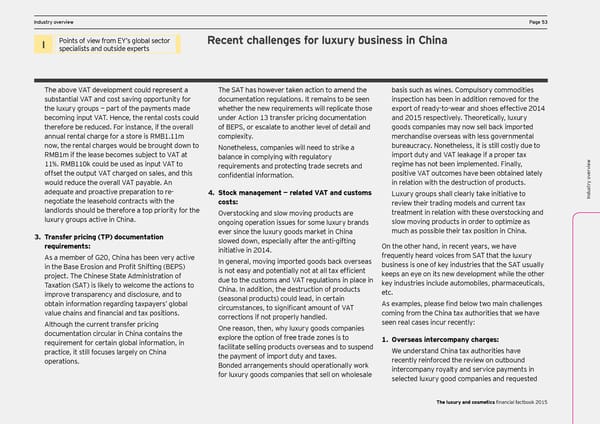DCF and vIndustry oaluation pverview arameters PPage 53age 53 I Points of view from EY’s global sector Recent challenges for luxury business in China specialists and outside experts The above VAT development could represent a The SAT has however taken action to amend the basis such as wines. Compulsory commodities substantial VAT and cost saving opportunity for documentation regulations. It remains to be seen inspection has been in addition removed for the the luxury groups — part of the payments made whether the new requirements will replicate those export of ready-to-wear and shoes effective 2014 becoming input VAT. Hence, the rental costs could under Action 13 transfer pricing documentation and 2015 respectively. Theoretically, luxury therefore be reduced. For instance, if the overall of BEPS, or escalate to another level of detail and goods companies may now sell back imported annual rental charge for a store is RMB1.11m complexity. merchandise overseas with less governmental now, the rental charges would be brought down to Nonetheless, companies will need to strike a bureaucracy. Nonetheless, it is still costly due to RMB1m if the lease becomes subject to VAT at balance in complying with regulatory import duty and VAT leakage if a proper tax w 11%. RMB110k could be used as input VAT to requirements and protecting trade secrets and regime has not been implemented. Finally, offset the output VAT charged on sales, and this positive VAT outcomes have been obtained lately ervie confidential information. v would reduce the overall VAT payable. An in relation with the destruction of products. try o adequate and proactive preparation to re- 4. Stock management — related VAT and customs Luxury groups shall clearly take initiative to Indus negotiate the leasehold contracts with the costs: review their trading models and current tax landlords should be therefore a top priority for the Overstocking and slow moving products are treatment in relation with these overstocking and luxury groups active in China. ongoing operation issues for some luxury brands slow moving products in order to optimize as 3. Transfer pricing (TP) documentation ever since the luxury goods market in China much as possible their tax position in China. requirements: slowed down, especially after the anti-gifting On the other hand, in recent years, we have initiative in 2014. frequently heard voices from SAT that the luxury As a member of G20, China has been very active In general, moving imported goods back overseas in the Base Erosion and Profit Shifting (BEPS) is not easy and potentially not at all tax efficient business is one of key industries that the SAT usually project. The Chinese State Administration of due to the customs and VAT regulations in place in keeps an eye on its new development while the other Taxation (SAT) is likely to welcome the actions to China. In addition, the destruction of products key industries include automobiles, pharmaceuticals, improve transparency and disclosure, and to (seasonal products) could lead, in certain etc. obtain information regarding taxpayers’ global circumstances, to significant amount of VAT As examples, please find below two main challenges value chains and financial and tax positions. corrections if not properly handled. coming from the China tax authorities that we have Although the current transfer pricing One reason, then, why luxury goods companies seen real cases incur recently: documentation circular in China contains the explore the option of free trade zones is to 1. Overseas intercompany charges: requirement for certain global information, in facilitate selling products overseas and to suspend practice, it still focuses largely on China the payment of import duty and taxes. We understand China tax authorities have operations. Bonded arrangements should operationally work recently reinforced the review on outbound for luxury goods companies that sell on wholesale intercompany royalty and service payments in selected luxury good companies and requested The luxury and cosmetics financial factbook 2015
 Seeking sustainable growth - The luxury and cosmetics financial factbook Page 54 Page 56
Seeking sustainable growth - The luxury and cosmetics financial factbook Page 54 Page 56